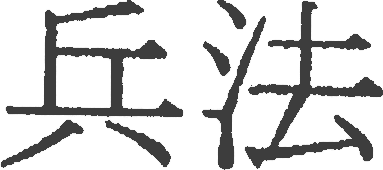Budo concepts to
be studied |
 |
Heiho |
|
|
"The warrior's (Hei) method (Ho)" : a military strategy Name given by Ito Ittosai Kagehisa (1560 - 1653 9 in his Itto-ryu Ken jutsu to a brand new conception in the fighting technique with a sword : the training has to aim more at the spiritual elevation than at the actual acquisition of techniques. Without a strong mental and outside the "right" spiritual attitude, the one who practices the art of the sword will only manage to destroy himself. This attitude has to be calm, pure and sincere (Makoto). It is the only way to turn the move of the opponent to one's advantage (Katsujin-no-ken). Heiko thus refers to a purely defensive attitude, in which there is no aggressivity. (It can be noticed that the Japanese characters for Hei-ho are read "the warrior's way" whereas the same ideograms are read "the way of peace" in Chinese). Defined as such, this new objective of the art of the sword (Ken-no-shinzui) will be aimed at, through the teaching of all the experts (Kenshi) of the sword to the ones of the Yagyu Shinkage-ryu of the Edo period (1603 - 1868), who will refer to it as Seiho.
|
|
Isshin-itto |
|
|
"One mind, one sword", expression used by the expert of the sword (Ken-jutsu) Ito Ittosai, to underline the fact that there can't be any technical efficiency without spiritual maturity. Ito Ittosai Kagehisa (1560 - 1653) thought indeed that it was no use for a man with no moral value learning an efficient fighting technique because this learning would only come to a way of destroying himself. He also thought that someone who aimed at mastering the sword had to master both literature (Bun) and the martial art (Bu). It was an obvious incentive for the warrior to aim, above all, at the forge of a more useful character for the peaceful society advocated by the Tokugawas. Itto-ryu taught the principle of Shin-ki-ryoku, which is the "power (ryoku) of the mind (shin) and of the inner energy (ki)", ready to commit oneself for a good cause even at the risk of one's life. That's why Ito Ittosai didn't like the name Ken - jutsu for his teaching because he thought it was too limited and too crude. He preferred the name Heiho, or Itto-ryu Heiho, because he said Ken-jutsu is the art of killing whereas Heiho is the art of protecting oneself. Even if the final results may be the same, the difference is fundamental in the attitude and spirit of the technique. It was always possible to defeat an opponent by killing him, but the highest level in the knowledge of Itto-ryu Heiho aimed at keeping the sword in its sheath as long as possible and thus at avoiding the confrontation using only the psychological advantage with which it is possible to prevent a potential assailant from attacking. We find here the meaning of the Mutekatsu (= victory without the hands) by Bokuden Tsukahara (1490 - 1571) who considered this possibility as the biggest possible victory over the opponent and oneself.
|
|

Heijo-shin-kore-do |
|
|
Also called Heijo - shin - kore - michi : "the ordinary conscience is the Way", famous answer given by master Zen Nansen Fugen to the question "what is the way ?" by his student Joshu Jushin during a Koan which brought the inspiration (Satori) to the latter. This answer refers to the state of mind (Heijo - shin) in which the mind, or the conscience, is not engaged in any direction, and simply remains at a balanced stage, that is to say "ordinary". During the 8th century, the Chinese master of Chan Ma-tseu (Baso in Japanese) already defined his Way as the one of the "every day mind" This notion has become the corner stone of the classical martial arts philosophy (Budo) of the ancient Japan. It can be found, among others, in the concept of Iwa - no - mi (= the body like a roc) described by Miyamoto Musashi for the art of the sword. The warrior's mental is present at all times of his life in Meijo-shin form, which is first of all a spiritual attitude but also goes on in a bodily attitude, the whole thing giving a very strong impression of stability, calm, self-control, stillness against the worst adversity. It should be the case on the battle field as well as in the very day life. That is the only way to efficiently face up the most unexpected things and to survive the fight. Seizing the essence of Hejo-shin-kore-michi was thus at the center of the preoccupation of the one who had chosen the Way of the weapons, the Samurai. Roland Habersetzer -
9th Dan Karatedo (extracts from an important book by Sensei Habersetzer, which will be
published in 2000 by Amphora.
|
|

